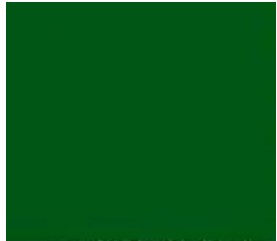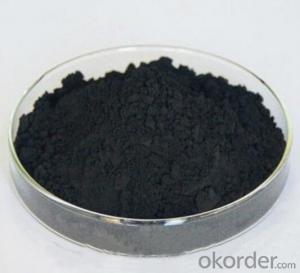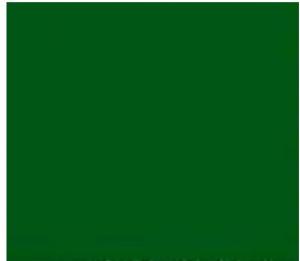Phthalocyanine Green G For masterbatch
- Loading Port:
- Qingdao Port
- Payment Terms:
- TT or LC
- Min Order Qty:
- 1 Metric Ton m.t.
- Supply Capability:
- 7,500MT/Year m.t./month
OKorder Service Pledge
OKorder Financial Service
You Might Also Like
Product Detail Of Phthalocyanine Green L8710 | |||||
Chemical Structure | CuPc Halide | ||||
Color Index No. | PG 7/74260 | ||||
Application | Paint | ||||
Physical Form | powder | ||||
| |||||
Test Items | Index | Test Method | |||
Relative Tinting Strength | 100 +_5% | DIN55986 | |||
ΔE,ΔL,Δa,Δb | ≤1,+1,+1,+1 |
| |||
| |||||
Items | Index | Test Method | |||
PH | 6.5~8 | DIN ISO 787-9 | |||
Density 20℃ g/cm3 | 2.1 | DIN ISO 787-10 | |||
BET m2/g | 61 | DIN 66131 | |||
Oil absorption g/100g | 32~42 | DIN ISO 787-5 | |||
105℃ Volatile Matter | ≤1.0% | DIN ISO 787-2 | |||
Water Solubles | ≤1.5% | DIN ISO 787-13 | |||
Residue on Sieve 100 mesh | ≤5% | DIN 53195 | |||
| |||||
Solvent Resistance | Index | Test Method | |||
Water | 5 | DIN ISO 105-A03 | |||
White Spirit | 4~5 | DIN ISO 105-A03 | |||
Ethanol | 4~5 | DIN ISO 105-A03 | |||
Acetone | 4~ 5 | DIN ISO 105-A03 | |||
Di methylbenzene | 4~5 | DIN ISO 105-A03 | |||
| |||||
Tolerance | Index | Test Method | |||
Light Fastness | 8 | DIN ISO 105-A03 | |||
Weather Resistance | 5 | DIN ISO 105-A03 | |||
Acid Resistance | 5 | DIN ISO 105-A03 | |||
Alkali Resistance | 5 | DIN ISO 105-A03 | |||
Hot Resistance | 230℃ |
| |||
Packing Details Of Phthalocyanine Green L8710 :
25kg/ PP bag , or as your requirements.
Applications Of Phthalocyanine Green :
1) Printing ink
2) Paint
3) Plastic
4) Rubber
5) Pharmaceuticals
6) Printing colors
7) Highly dispersible
8) High density pigment used for addition of coloration
9) Limited anti-dissolvent and anti-flocculability
10) High temperature resistance and sunshine resistance




- Q: What is better, Mac eye pigments or the regular eyeshadow? Also, has anyone tried the mixing medium solution?
- the pigments are more concentrated, but there's more of a color variety with the shadows. on the shadows, if you look under the name it'll tell you the formulation...satin, luster etc...but the ones marked luster and frost are my favorites and they are more vivid and as far as the mixing medium, just dampen (dont wet) your brush and its the same
- Q: what is the pigment in hibiscus?
- Hibiscus flowers bear pigments of three types: carotenoids, anthocyanins, and flavonols. The exact pigments (all three of those types are actually sizeable families of similar chemicals) and the exact proportions depend on the color of the particular flower: there are literally several hundred species in the genus Hibiscus, and they come in all shades of red, pink, yellow, and orange. Carotenoids are oil-soluble, fairly stable pigments that come in all shades of red, orange, and yellow. Anthocyanins are water-soluble and significantly less stable: they're responsible for the blues, pinks, purples, and reds, and in high concentrations can produce colors so dark as to look black. Flavonols are the least vivid of the pigments: they produce pale pastel yellows, cream colors, and off-whites. (Plain white flowers usually have no visible pigment at all.) Flavonols actually do most of their color absorption in the UV spectrum: they're the plant equivalent of the melanin in human skin, keeping them from getting sunburnt.
- Q: What does it mean when something is highly pigmented?
- Pigment is color. When someone says something is highly pigmented it means that the color is bright or really vibrant. Hope this helped!
- Q: Compare and contrast pigment color with the color seen from a light. What is the difference between mixing pigment colors and mixing light colors?
- you notice pigments the colour you notice them, using fact they replicate a spectra of sunshine, with particular frequencies, and take up all others seen to the human eye. in case you combine distinctive monochromatic mild with distinctive colours (as seen on the television: purple, green and blue it quite is referred to as additive mixing, or magenta, yellow and cyanide that's the different technique) your retina will upload the colors up, and experience it as a distinctive shade. (by skill of including each and all of the three colours on an identical intensity, you are able to create white mild) while mixing pigments (they are chemical compounds) you get a clean cloth, which will replicate an different spectra of sunshine, which you will see as a shade
- Q: a question on my photosynthesis test review...=_=
- they absorb light of a particular wavelength (the reason they are green). The energy from the light is transferred to the pigment in the form of excited electrons within the pigment.
- Q: wut is the diff between those 2?
- MAC pigment is a loose eyeshadow that comes in a jar. It is made with ingredients that help adhere to the skin it is also easy to blend and doesn't cake. It is also to use pigment if you want very intense colors. And MAC eyeshadow well it comes in a little case it is in powder form it's a lot easier to apply than the pigment because the pigment tends to get all over the place. Personally I like the eyeshadow better more shades and easier to apply.
- Q: i bought the new neon pro pigments from mac , well 5 out of the six and i also bought 'basic red'i want to use these as eye shadows but i dont know howi also bought mac mixing medium for face and body but lol , i dont know how to use any of this stuffwhat can i do to use this stuff i mean will it turn out like regular eyeshadow if i use it right? will there be a shine to it? it will reduce fall out? should i put the mixing medium on my eye first , then let dry?do i need to possibly press the pigments in a pot with some kind of eye shadow liquid?i also bought the mascara mixing medium but want to know exactly what to do with thatand also , can i mix any of the pigments with lipgloss?http://cn1.kaboodle /hi/img/2/0/0/119/a/AAAAAlrx1LUAAAAAARmgiA.jpg
- look on youtube they have all the answers!
- Q: What are the roles and type of plant pigments?
- Pigments are able to absorb specific wavelengths of light which power photosynthesis. Chlorophyll, which is green, absorbs all wavelengths except green. Each photon excites an electron in the light harvesting complexes of a photosystem in a chlorophyll molecule, eventually producing ATPs. Other pigments will be a different color and will be able to absorb other wavelengths, maximizing energy absorbency when the sun's rays change. Pigments are chemicals inside living things that absorb certain types of light. In plants, the pigment chlorophyll in leaves absorbs sunlight for photosynthesis to work, where the energy comes from. Chlorophyll absorbs all light except green, which is reflected. That's why most plants are green...
- Q: As in like makeup pigments??????
- pigments are severe colored, powder version of the eyshadows. AS FOR THE L'OREAL HIP.... defanatly in specific cases they may well be in comparison to MAC pigments. they're severe high quality. great, vivid, relaxing pigmention. in a sort of colorings. in case you prefer to attain the *POP* much extra, attempt making use of a watch shadow primer. they do wonders! you may purchase the dearer ones from Sephora or the drugstore one that is Loreal shrink. they make the colors extra vivid. does not crease. keeps them on longer. over all great stuff ;D desire i helped(:
- Q: What are leaf Pigments?
- Pigments that are present in the leaf that impart colour to the leaf are called leaf pigments. They are chemical compounds. Green colour in plants is due to Chlorophyll. Cholorophyll are also of different types Chlorophyll-A, Chlorophyll-B, Chlorophyll-C and Chlorophyll-D. Different colours are imparted to plants by different pigments. Some are Xanthophyll and Carotenoids.
Send your message to us
Phthalocyanine Green G For masterbatch
- Loading Port:
- Qingdao Port
- Payment Terms:
- TT or LC
- Min Order Qty:
- 1 Metric Ton m.t.
- Supply Capability:
- 7,500MT/Year m.t./month
OKorder Service Pledge
OKorder Financial Service
Similar products
Hot products
Hot Searches
Related keywords























